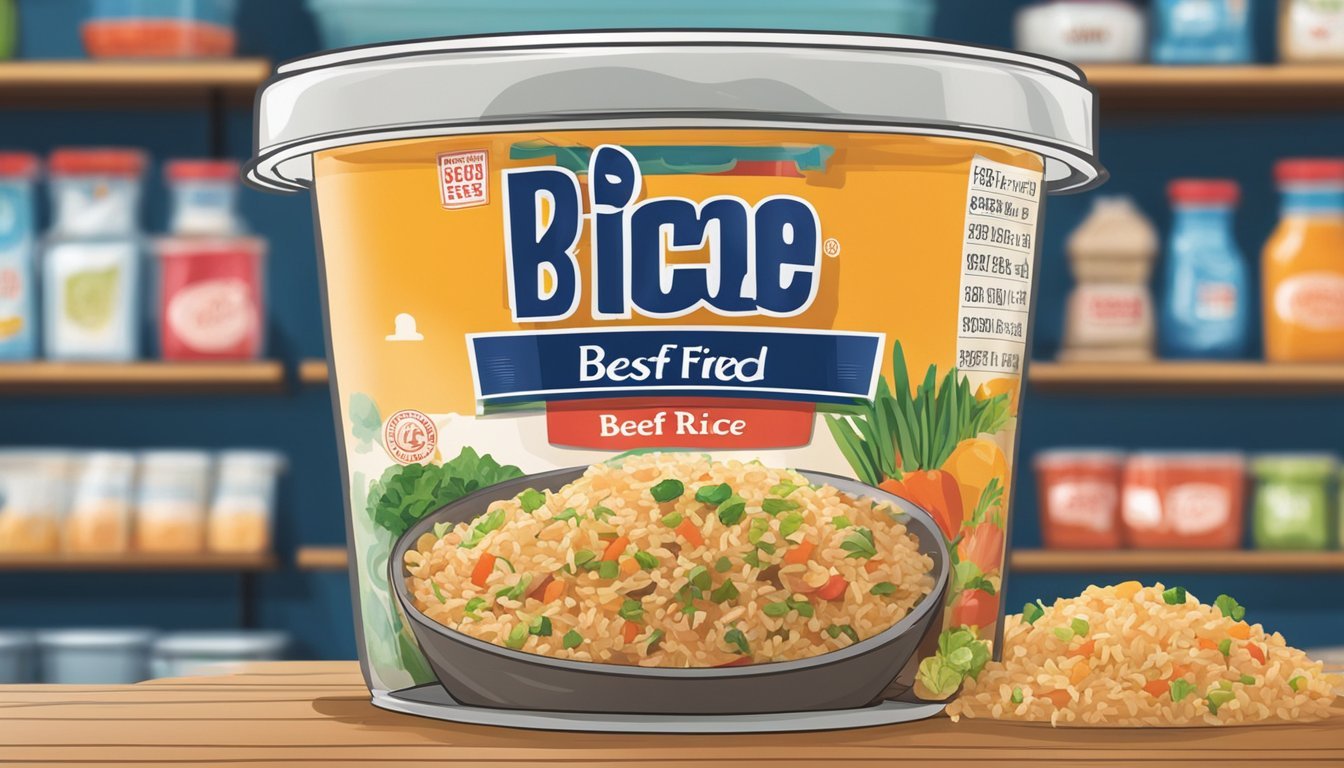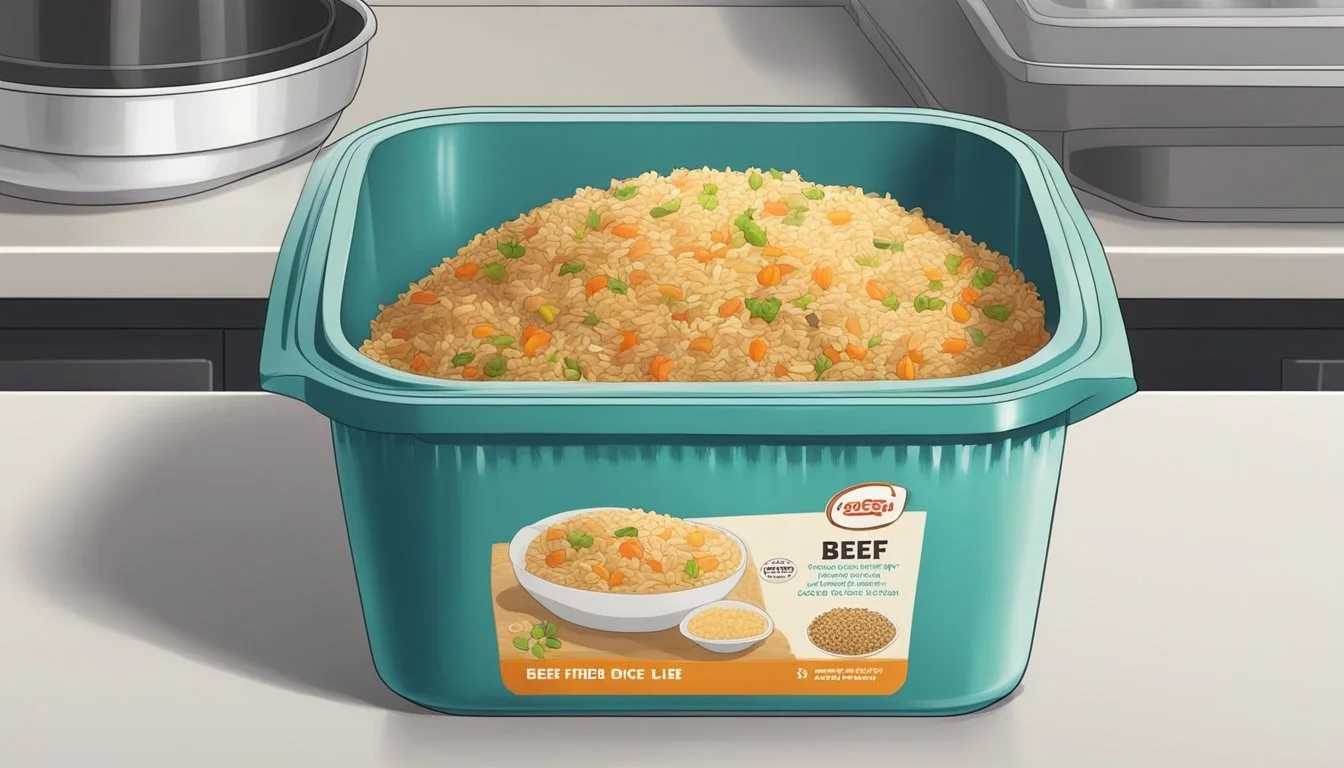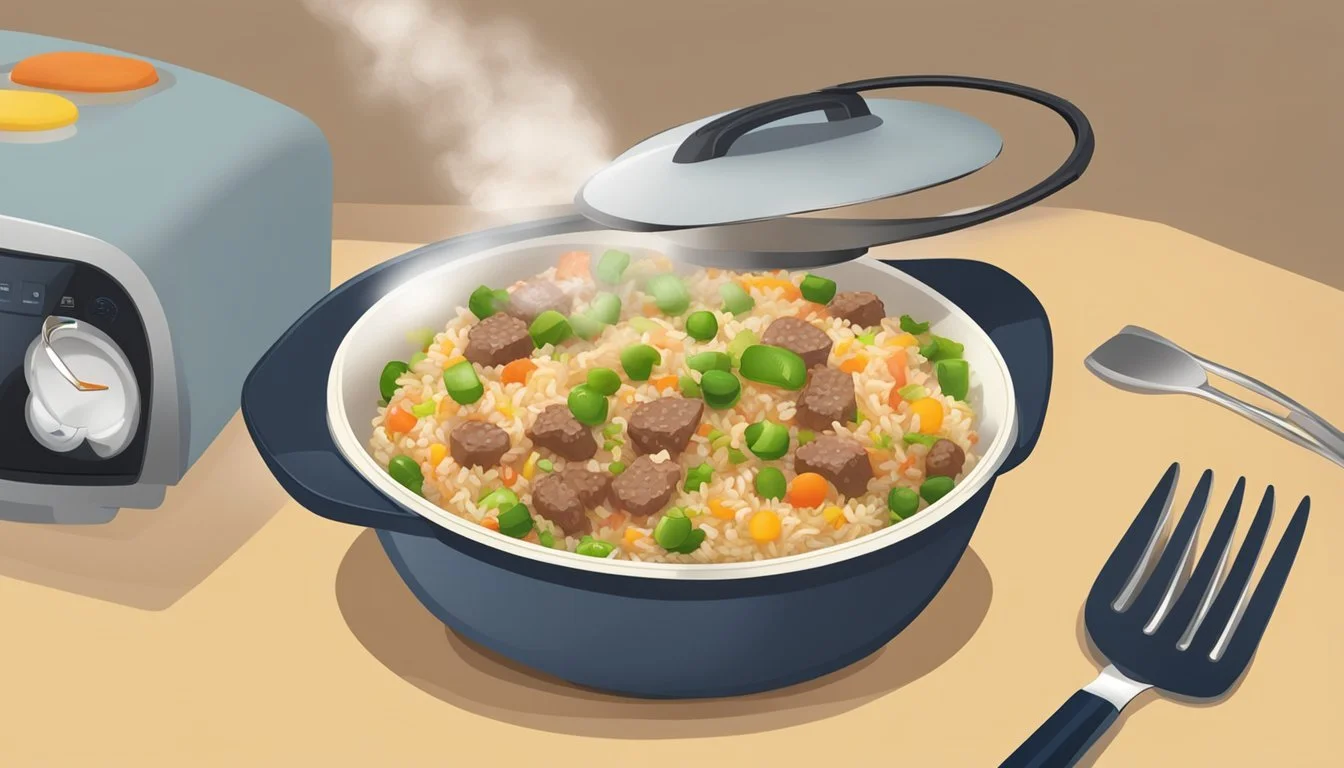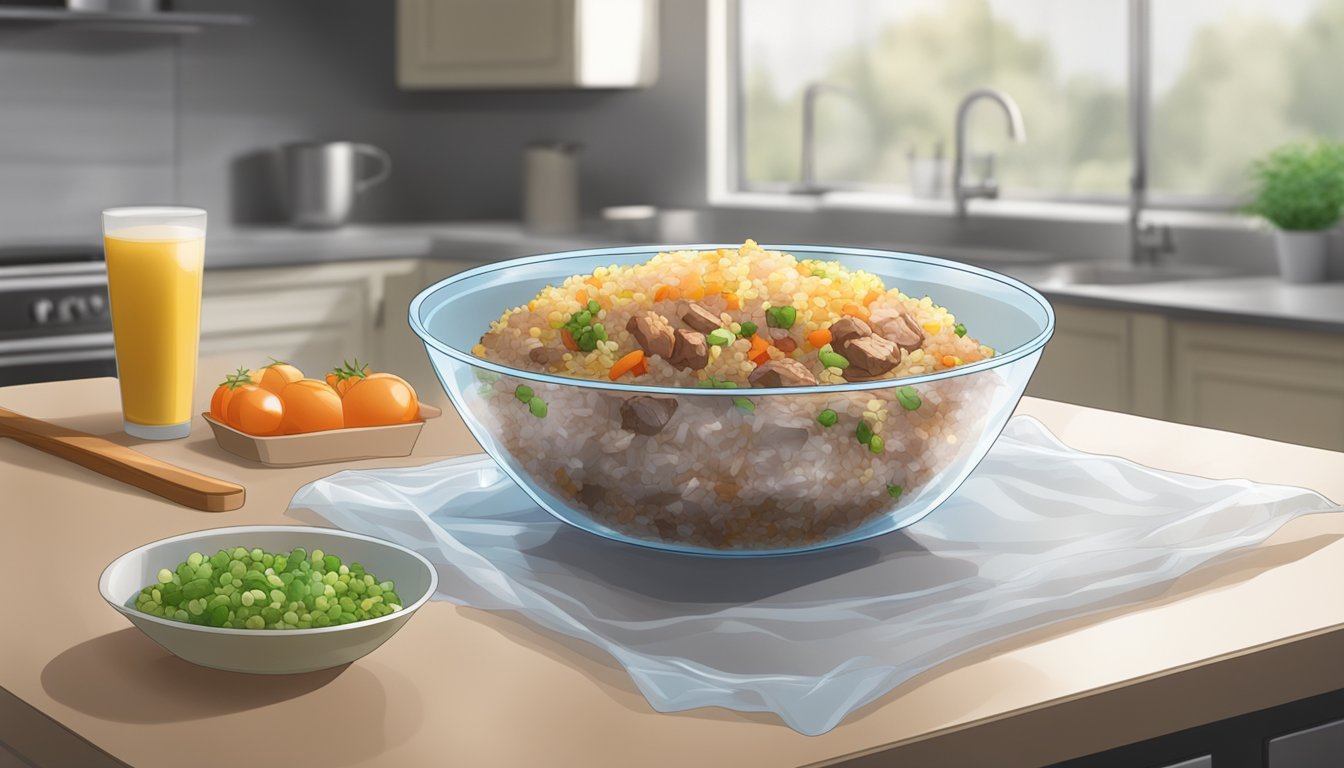How Long Does Beef Fried Rice Last?
Storage Tips and Shelf Life
When it comes to enjoying beef fried rice, knowing how long it lasts is crucial for both safety and taste. Properly stored in an airtight container, beef fried rice can last 5 to 7 days in the refrigerator. This timeframe ensures that the dish maintains its quality and is safe to consume.
Reheating practices also play a vital role. Ensure the beef fried rice is thoroughly reheated to eliminate any potential bacteria. For those looking to store it even longer, freezing is an effective method, allowing the dish to be kept for up to six months without significant loss of quality.
Understanding these storage guidelines not only helps prevent foodborne illnesses but also allows you to savor the delightful flavors of beef fried rice whenever you crave it. These tips ensure your favorite takeout meal remains delicious and safe to enjoy.
Understanding the Shelf Life
Beef fried rice's shelf life is influenced by storage conditions and preparation methods. Proper handling ensures food safety and maintains quality.
Factors Affecting Shelf Life
The storage temperature plays a critical role. Beef fried rice should be refrigerated within two hours of cooking to prevent bacterial growth. Storing it in airtight containers at a consistent temperature below 40°F (4°C) extends its safety and quality.
Bacterial growth is another factor. The presence of moisture provides a breeding ground for bacteria. Reducing moisture by storing the rice properly can help decrease the risk.
Reheating practices also affect shelf life. Thoroughly reheating beef fried rice to at least 165°F (74°C) before consumption ensures any potential bacteria are killed.
Difference Between Homemade and Takeout
Homemade beef fried rice typically lasts longer due to more controlled preparation and storage. Being mindful of cleanliness and prompt refrigeration can maximize its shelf life to about 5-7 days.
Takeout fried rice, on the other hand, might have a shorter shelf life. It's often exposed to varying temperatures during transport. It's best to consume takeout rice within 3-4 days to ensure safety.
Both homemade and takeout versions can be frozen for longer storage. Properly freezing the rice in airtight containers can extend its shelf life up to 6 months. Defrosting and reheating should still follow food safety guidelines.
Proper Storage Techniques
To maximize the freshness of beef fried rice, effective storage techniques are crucial. Attention to refrigeration and freezing practices, as well as the use of airtight containers, ensures safe consumption and maintains the dish's quality.
Refrigeration Guidelines
Store beef fried rice in the fridge at a temperature of 35-40°F (1.6-4.4°C). Cool the fried rice to room temperature within two hours of cooking. Place it in the back of the fridge where the temperature is most stable.
Keep the rice in shallow containers to accelerate cooling and prevent bacterial growth. Avoid storing it in the fridge door, as frequent opening can cause temperature fluctuations. Always reheat the rice thoroughly before consuming, ensuring an internal temperature of at least 165°F (74°C).
Freezing and Thawing Methods
For longer storage, freezing beef fried rice is an excellent option. Cool the rice completely before transferring it to the freezer to avoid raising the internal temperature of the freezer. Use heavy-duty freezer bags or airtight containers to prevent freezer burn and preserve flavor.
Portion the rice into meal-sized servings for convenience. Label each container with the date to track storage time. Frozen fried rice can last up to three months. Thaw it safely in the fridge overnight before reheating, or reheat directly from frozen using the microwave or stovetop, ensuring it reaches 165°F (74°C).
Airtight Containers and Their Importance
Utilizing airtight containers is essential for maintaining the quality of leftover fried rice. These containers prevent moisture loss, contamination, and the absorption of other refrigerator odors.
Choose BPA-free plastic or glass containers with tight-fitting lids. For added convenience, containers with vented lids can directly go from fridge to microwave, making reheating easier. When freezing, ensure the containers are freezer-safe to prevent cracking and maintain a tight seal. Properly using airtight containers extends the shelf life and ensures the beef fried rice remains safe and delicious.
Identifying Spoilage
When determining if beef fried rice has gone bad, it's important to recognize changes in sensory characteristics and be aware of microbial contamination risks.
Sensory Indicators of Spoilage
Examining the sensory characteristics can help pinpoint spoilage. Smell is one of the first indicators. Spoiled fried rice often emits a sour or unpleasant odor. Color changes are another clue; if the beef appears gray or has dark spots, it may be spoiled.
Check for mold growth, which can appear as fuzzy patches in various colors. Taste should not be relied upon due to the risk of ingesting harmful pathogens, but a noticeable off-flavor often confirms spoilage.
Microbial Spoilage and Foodborne Illnesses
Spoiled fried rice can harbor harmful bacteria leading to foodborne illnesses. Bacillus cereus, common in rice, can cause sickness if the rice isn't properly stored. Symptoms of food poisoning include nausea, vomiting, and diarrhea.
Food poisoning risks increase if the rice has been stored at improper temperatures or left out for too long. Preventing microbial spoilage involves refrigerating the dish promptly, keeping it at temperatures below 40°F, and reheating it to at least 165°F to kill any bacteria present.
Reheating and Consuming Leftovers
When it comes to reheating and consuming leftover beef fried rice, ensuring food safety while preserving flavor and texture is crucial. Critical steps include proper reheating methods and adhering to recommended temperature guidelines to make sure the dish remains safe to eat.
Safety Tips for Reheating Rice Dishes
To safely reheat beef fried rice, it is important to reach an internal temperature of 165°F (74°C). This kills any bacteria that may be present. Always use a food thermometer to verify the temperature.
Leftovers should not be left at room temperature for more than two hours. Bacteria can grow rapidly in food that is not stored properly. Refrigerate beef fried rice within that time frame to prolong its shelf life.
When reheating, ensure the rice is steaming hot throughout before consumption. Avoid reheating leftovers more than once, as repeated cooling and reheating cycles can increase the risk of foodborne illness.
Recommended Reheating Methods
Microwave: Place beef fried rice in a microwave-safe container. Cover with a lid or microwave-safe wrap, leaving a small opening for steam to escape. Heat on high, stirring every minute until reaching an internal temperature of 165°F (74°C).
Stovetop: Use a non-stick pan for even heating. Add a tablespoon of water or broth to prevent sticking and help create steam. Stir occasionally and cook until the rice reaches the safe temperature of 165°F (74°C).
Oven: Preheat the oven to 350°F (175°C). Put the rice in an oven-safe dish, cover with foil, and bake until the internal temperature hits 165°F (74°C), which usually takes about 20 minutes, depending on the quantity.
Using proper reheating methods ensures the beef fried rice remains not only tasty but also safe to eat.
Maximizing Taste and Quality After Storage
Proper storage and reheating techniques can greatly influence the taste and quality of beef fried rice after it has been refrigerated or frozen. Follow these guidelines to maintain the best texture, flavor, and overall quality.
Maintaining Flavor and Texture
Refrigerate beef fried rice within two hours of cooking to minimize bacterial growth. Use airtight containers to preserve moisture and flavor. Ensure the fried rice is evenly distributed in the container, as clumps can lead to uneven reheating.
Add a small amount of oil to a pan before reheating to restore some of the original texture and to prevent sticking.
Stir the rice occasionally while reheating to ensure even heat distribution.
If using a microwave, cover the container with a damp paper towel to retain moisture.
These methods will help maintain the texture and enhance the original flavors, ensuring the dish tastes as close to fresh as possible.
Best Practices for Long-Term Quality Retention
Freezing fried rice can extend its shelf life up to 6 months, but following proper storage procedures is crucial. Use covered, airtight containers to prevent freezer burn and maintain quality.
Steps for freezing:
Cool the rice quickly before freezing to avoid a soggy texture.
Spread the rice in a thin, even layer on a baking sheet to speed up cooling.
Once cooled, transfer the rice to airtight containers or zip-lock bags, removing as much air as possible.
Thaw the rice overnight in the refrigerator.
Reheat in a pan with a small amount of oil and stir frequently for even heating.
Properly stored and reheated beef fried rice will maintain its flavor and texture, allowing you to enjoy the dish even after several months.
Health and Nutritional Considerations
When consuming beef fried rice, it's essential to understand both its nutritional benefits and the potential health risks if leftovers are spoiled.
Nutritional Content of Beef Fried Rice
Beef fried rice is a nutritious option that combines various ingredients, each contributing specific benefits. Protein from beef and eggs provides essential amino acids necessary for muscle repair and growth.
Veggies, such as carrots, peas, and onions, add vital vitamins and minerals. While the exact nutritional content can vary, a typical serving of beef fried rice might contain the following:
Nutrient Amount per Serving Protein 15-20 grams Fiber 2-4 grams Carbohydrates 40-50 grams Fats 10-15 grams
Fiber from any added vegetables also aids in digestion. However, one should note the higher calorie and fat content, influenced by oil use during cooking.
Health Risks of Spoiled Leftovers
Proper storage of beef fried rice is crucial to prevent foodborne illnesses. Leftovers should be refrigerated within an hour of cooking to inhibit bacterial growth.
Spoiled fried rice can harbor bacteria like Bacillus cereus, which can lead to food poisoning. Symptoms of consuming spoiled rice include vomiting, diarrhea, and other gastrointestinal issues.
To minimize risk, leftovers should only be stored for 4-5 days in the fridge. Vegetarian versions of fried rice, though free from meat, also require careful handling to avoid spoilage. Ensuring thorough reheating before consumption is essential for safety.
By adhering to these guidelines, one can enjoy beef fried rice without compromising health.
Recipe Variations and Ingredients
Beef fried rice offers flexibility in its ingredients, making it easy to customize according to taste preferences and dietary needs. Key components include a variety of proteins, vegetables, and sauces.
Common Ingredients in Beef Fried Rice
Rice: Typically, jasmine rice or long-grain white rice is used. Leftover rice, preferably a day old, creates the best texture.
Beef: Common choices include ground beef or thinly sliced flank steak. The beef is usually marinated and seared.
Vegetables: Onions, peas, bell peppers, and broccoli add crunch and color. Green onions are often used for garnish.
Egg: Scrambled eggs are integrated into the rice for added protein and texture.
Sauces: Soy sauce, dark soy sauce, and oyster sauce are standard. Sesame oil and a bit of sugar enhance the flavors.
Aromatics: Garlic and onions are sautéed in oil to start the cooking process.
Substitutions for Dietary Restrictions
For those with dietary restrictions, several substitutions can be made:
Vegetarian: Replace beef with tofu, tempeh, or a mix of extra vegetables such as mushrooms and corn. Use vegetarian oyster sauce.
Gluten-Free: Use tamari or gluten-free soy sauce. Ensure all sauces and seasonings are labeled gluten-free.
Low-Carb: Substitute rice with cauliflower rice or use brown rice for a higher fiber option.
Low-Sodium: Reduce the amount of soy sauce or use a low-sodium variant. Limit additional salt.
Vegan: Omit the scrambled egg and beef. Increase the vegetable content and use vegan alternatives for sauces where necessary.
Preserving Leftover Fried Rice
Preserving leftover beef fried rice involves using proper storage techniques and effective labeling to ensure it remains safe and tasty for future meals. Utilizing airtight containers and freezing can significantly extend its lifespan.
Techniques to Extend Lifespan
Proper storage helps maintain the quality of beef fried rice. Airtight containers are essential for this. They should be used to store the rice within two hours of cooking to prevent bacterial growth. Refrigerating the rice in these containers allows it to last for 5 to 7 days.
For longer storage, freezing is a reliable method. Divide the rice into portions and place it in heavy-duty freezer bags or covered airtight containers. This can keep the rice in good condition for up to 6 months. Reheating should be done carefully to avoid drying out; adding a teaspoon of water can help retain moisture.
Labeling for Effective Rotation
Properly labeling leftover beef fried rice aids in maintaining a safe and organized storage system. Use clear, adhesive labels to mark the date of storage on each container. This practice ensures you can easily identify the age of the rice and use older portions first.
Effective rotation follows the “first in, first out” principle. Place newer containers behind existing ones in the refrigerator or freezer. This method minimizes food waste and ensures that the rice consumed is always fresh. Labeling also helps in monitoring the storage environment, allowing timely adjustments if necessary.
Frequently Asked Questions
Beef fried rice can be stored in different conditions, but it's important to know how long it can last and if it's safe to consume when cold. Understanding these details ensures you enjoy your meal safely.
Can You Eat Cold Fried Rice?
Yes, cold fried rice can be eaten as long as it has been properly stored. After cooking, let the beef fried rice cool to room temperature for no more than two hours before refrigeration. Store it in an airtight container to prevent bacterial growth.
Cold fried rice must be consumed within 4-5 days when stored in the refrigerator. It is important to reheat the rice thoroughly before eating if it shows any sign of potential spoilage, such as off smells or unusual texture. The internal temperature should reach 165°F (74°C) to kill any bacteria that may have developed.
Always practice proper food safety to avoid foodborne illnesses.
How Long Can Beef Fried Rice Stay in the Pantry?
Beef fried rice should never be stored at room temperature in the pantry. The rice can quickly become a breeding ground for bacteria, increasing the risk of foodborne illnesses.
If left out at room temperature for more than two hours, it should be discarded. The risk of bacterial growth, particularly Bacillus cereus, is high once the food reaches the “danger zone” temperatures (40°F - 140°F or 4°C - 60°C).
It's crucial to refrigerate beef fried rice promptly or freeze it for longer storage to maintain its safety and quality.











